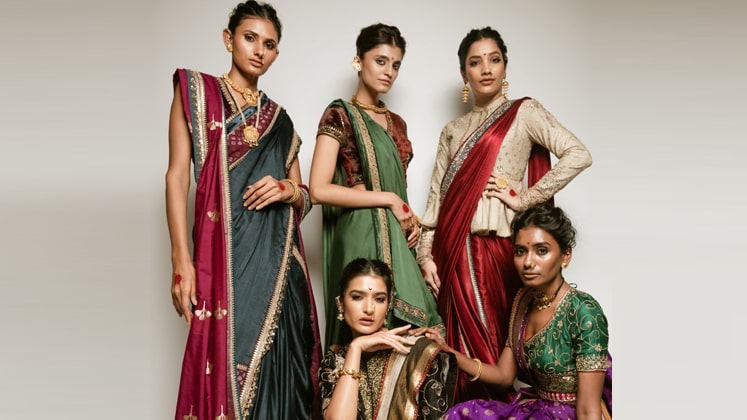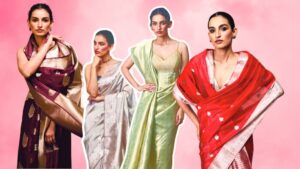A traveller, thinker, dreamer and designer, Anju Modi launched her eponymous brand in 1990, with her love for textiles and the Indian craft serving as the main catalyst and foundation of her designing philosophy.
A key changemaker in the field of design, Anju Modi serves as a custodian of Indian tradition and strives to provide contemporary innovation to age-old crafts and textiles within the industry. A fact not known to many is that, every season, Anju Modi’s couture and ready-to-wear collections are built around themes showcasing the extraordinary skills of Indian artisans in a bid to preserve handicraft practices from extinction, keeping their rich history alive and empowering local rural communities.
Following this practice, Anju Modi has, single-handedly, revived multiple age-old techniques that were long forgotten, by creating an extensive library of research and development techniques for weaving, vegetable dyeing, block printing and traditional embroidery.
In terms of design, philosophical references and architectural marvels come alive in many of Anju Modi’s pieces with each ensemble painstakingly decorated to reflect, enhance and celebrate the cultural history of various cities and regions of India.
The designer has also been critically acclaimed for her costume designs for Indian films RamLeela (which garnered her the Life Ok Screen Awards and The Start Guild Awards, along with a nomination for Filmfare 2013 for Best Costume) and more recently, Bajirao Mastani, that featured ensembles inspired by the Persian and Maratha era of the Indian History.
Apparel Resources (AR) speaks to the highly acclaimed and multi-faceted designer in an exclusive interview as we unravel the brand’s inception, its exceptional work in the field of reviving age-old Indian crafts and textiles, how it is merging the old with the new to cater to the consumers of today and its plans for the future.
INCEPTION
With a formal training in design, Anju Modi started her journey in the industry with an ambition to make a difference in the world of fashion and design and at the same time, keep her love for Indian crafts alive so as to make the world witness the sheer beauty of the treasures close to home.
“By 1990, I was equipped with enough knowledge on textiles and fabrics, so that’s when I decided to take the plunge and launched my brand. I was like a blank canvas with an ambition to make a difference. I wanted to use all the resources I had and couple those with my love for Indian textiles,” Anju Modi, Creative Director, Anju Modi Brand told AR in an exclusive interview.
“In terms of work experience, first-hand interaction with the local weaver’s community, dyers, craftsmen, etc., was all I had. It is those experiences that have shaped me personally, as a creative professional and even my brand. I developed a better understanding of fabrics, textiles and deeper nuances of crafts while working with them,” she added.
Anju’s interest in India’s prized textiles and crafts is what inspired her to start her own brand. The designer also credits her birthplace, Ranchi, for fuelling her fondness for the arts, which inspired her to bring the region’s local craftsmanship to the forefront and create awareness amongst people to value the vast range of textiles and culture our country is blessed with.
PRODUCT CATEGORY AND PRICING
Anju Modi offers something for everyone to choose from. With a broad range of wedding couture, luxury pret and occasionwear, consumers have a wide variety of lehenga sets, anarkali sets, dresses, kurtis and tunics that can be worn for lighter functions as well as for formal lunches and dinner parties to even weddings, to choose from.
The garments are designed with utmost precision and a lot of research goes into putting a collection together. Hence, every outfit you see is handcrafted to detail and is designed to last for decades, so it’s timeless and sustainable also.
Starting from Rs.14,000, the prices of products at Anju Modi go up depending upon the amount of work done over them.
“The main reason for being involved with people from various regions is that it adds diversity to our brand. Local areas have so much to offer which in turn, benefits the brand and its intention to bring Indian crafts to the forefront,” – Anju Modi, Creative Director, Anju Modi Brand
In terms of collections, the brand launches 6 to 8 collections per year based on seasons and since India is a land of various cultures, the festive season is an addition. The number of pieces per collection are controlled based on the total number of orders the brand receives on a particular outfit. This in turn, helps it to be more mindful and careful of the waste produced as well as overproduction.
MANUFACTURING AND SOURCING
Most of Anju Modi’s outfits are produced in-house at its design studio in Noida which currently comprises a team of over 50 people. However, they also work with various suppliers based in different states in India.
Commenting on the same, Anju said, “The main reason for being involved with people from various regions is that it adds diversity to our brand. Local areas have so much to offer which in turn, benefits the brand and its intention to bring Indian crafts to the forefront.”
She further added, “The suppliers that the brand regularly works with include those from Kota, Venkatgiri, Kutch and Banaras, amongst others.”
Over the years, Anju Modi has built a strong repertoire of the techniques and nuances of textiles through research and by working closely with the master craftsmen as well as weavers across the country. In terms of crafts, one can easily get glimpses of India in Anju Modi’s creations. This alone has served as a significant reason behind the brand’s clothes being considered as heirlooms, explaining why people have felt emotionally connected to them for decades.
“To come up with something that lasts forever, takes an equal amount of work. We look for artisans all over the country and get our fabrics, textiles and materials done from the best. My personal favourite has to be Bandhej from Gujarat. We also have artisans from Paithan, Maheshwar, amongst others,” Anju explained.
The brand’s success in its endeavours to promote craftsmanship, is clearly apparent in its intricately crafted creations.
That being said, every outfit at Anju Modi is a result of the coming together of various textiles. Before deciding on the fabric, the team does a thorough research on the correct fabrics and the best place that it can either be sourced from or made.
When it comes to outsourcing fabrics and raw materials, the quality of textiles serves as the utmost priority for the label. Some common regions the brand works with in this regard are Venkatgiri, Kutch, Baranas, Indore, etc.
| 1990 to 1993 – Developed a new blended fabric in Varanasi, by reviving the classic tradition of working with zari. (real silver thread)
1993 to 1995 – Improved variations in the Bandhani tie-and-dye techniques, by introducing alterations through geometrical patterns and neutral colourways. 1995 to 1999 – Nurtured modern interpretations to the Kota Doria fabrics, Sanganeri block printing techniques and Bagru textile crafts originated from Rajasthan by collaborating with local artisans and coaching the application of these crafts in innovative designs. 2000 to 2001 – Contributed to the modernisation and improvement of chanderi weaving and patterns. Developed the lurex yarn weaving technique for chanderi silk. 2001 to 2002 – Cultivated a new range of rich khadi, by coaching the development of slub-yarn techniques for a new line of modern luxury silhouettes. 2003 to 2004 – Worked with UNIDO (United Nations Industrial Development Organisation) under a cluster development programme with 1500 craftsmen and artisans, developing skills and innovative techniques for the Kota Doria craft. 2006 – Developed ‘boiled wool’ techniques for a new range of woolen angrakha coats which were selected for presentation at the Hyères fashion festival in Paris. Also, presented the collection at the Miami Fashion Week. 2016 – Designed and developed a special woven fabric in Varanasi for Neelambar collection. Neelambar poetically uses sona and rupa for a prosaic collection of traditional techniques. An architecture-inspired collection that has organic elements with structural silhouettes and design details of the minarets, Neelambar is an outtake of our rich textile legacy; an attempt to weave the traditional knowledge and skills of our master craftsmen with threads of modernity. 2017 – Rajasthan serves as the inspiration behind the collection Sunehri Kothi. The miniature art, that found its genesis in Rajasthan, emblazoned through the palaces, narrates the splendour of yesteryears not only through the imagery but also with the fine meenakari craftsmanship, the intricate and detailed brush-work, and the remnants of the colours – handmade from minerals, vegetables, indigo, conch shells and embellished with precious stones, pure gold and silver. |
TECHNIQUES AND DETAILS
Experimentation, research, playing around with different textiles and materials and finding treasure amongst archives is what makes Anju Modi’s pieces stand out in the market.
“What I love the most about our garments is not just the fact that we use Indian textiles and crafts but it’s also how we use them. We’re constantly researching and experimenting with what we have. I find it quite interesting to bring crafts from different states and marry them together, resulting in a very vibrant outfit,” Anju Modi said.
SUSTAINABLE AND ETHICAL PRACTICES
Anju Modi- the brand, was built on ethical grounds and creating garments that are meant to last over decades. Therefore, as a brand, it is in their genes to function on the same brand philosophy even today.
To achieve the same, the team at Anju Modi starts by finding what they have in their archives and how it can be incorporated into their vision for the new collection. Hence, they utilise past swatches to get inspired from and develop new ones using those ideas. During the whole production process, it is kept in mind that no excess material aside from what they require, is used. The leftovers are used to create the brand’s trims and accessories that in turn, add a beautiful touch to the garment and look quite exquisite.
“What I love the most about our garments is not just the fact that we use Indian textiles and crafts but it’s also how we use them. We’re constantly researching and experimenting with what we have. I find it quite interesting to bring crafts from different states and marry them together, resulting in a very vibrant outfit.” – Anju Modi, Creative Director, Anju Modi Brand
Anju Modi’s pieces are available to shop at the brand’s atelier, flagship store and via various multi-designer stores in India and internationally. The brand also takes online orders via its e-commerce website www.anjumodi.com.
“People find us on different social media platforms and then place their orders either on the website or in person. The intention is to always keep growing and improving ourselves with time, while keeping our brand ethos intact. As for plans, I would love for us to adopt more sustainable and eco-friendly measures and practices,” Anju concluded.
AR: What is one valuable lesson/skill you learnt while running a successful fashion business in the Indian landscape that you wish you’d known prior to starting the label?
AM: I believe everything happens when it is meant to happen. You walk on your own timeline, and you learn things on the go. So, I feel extremely content with how life has turned out for me and for all the lessons I’ve learnt while navigating this enriching journey.
AR: What, according to you, is driving consumption in fashion categories in the Indian market?
AM: Consumption is based on various factors. Apart from personal and economic factors, psychological as well as social factors also drive one’s consumption behaviour. I believe easy accessibility of products has definitely led to an increase along with social media and the internet as a whole. E-commerce has become a huge thing and has a very high chance of growing in the future as well.
AR: What led you to explore the world of costume designing and films? How is it different from designing a collection for direct consumers?
AM: I’ve been interested in our crafts, culture, history and heritage for as long as I can remember. The love for textiles has been a constant in my life and I believe it was that very thing that makes me want to experiment more. Costume designing was a wonderful opportunity for me to expand my boundaries and go into the depths of our historical characters and the time period.
Creating well-tailored clothing for a client is what we aim for while designing. We analyse the client’s needs and requirements and recommend the best solution for them.
Creating a costume also takes an extensive amount of research. It is essential to remain authentic to the screenplay, characters and time period. It is critical to comprehend the plot in order to adhere to the culture, history, values and so on. Therefore, fabrics, colours, designs, stitching methods and so on are chosen according to the specifications of the plot and the director.









